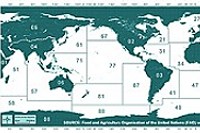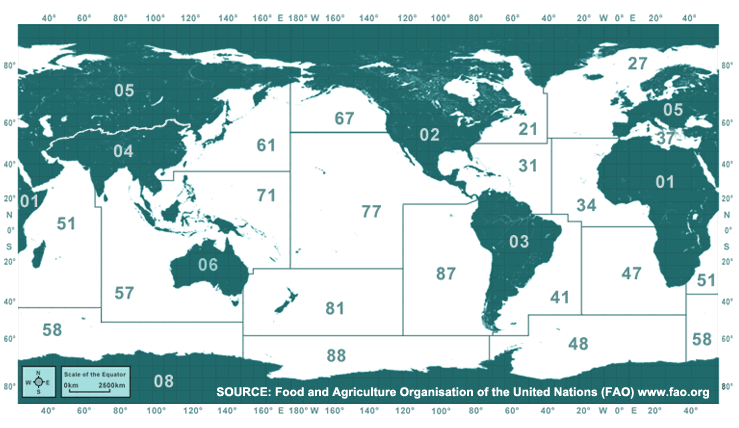 In many parts of the world, food items have to be labelled so that consumers know what they are buying. In the European Union, legislation on fish and fisheries products for human consumption requires that at least the following elements are provided in a clearly readable manner:
In many parts of the world, food items have to be labelled so that consumers know what they are buying. In the European Union, legislation on fish and fisheries products for human consumption requires that at least the following elements are provided in a clearly readable manner:
-
the name, possibly the scientific name for unequivocal identification (for fishes, you can check them in FishBase, for other marine organisms, check in SealifeBase)
-
the FAO area where the fish or seafood item originates from
-
the production method – through capture in the wild or through aquaculture.
Have a look at the map of FAO areas below to see what type of broad geographical description to expect.

These very basic rules are often not respected, so you don't know what you are buying. How then can you make a conscious and responsible purchasing decision?
Why is this particularly important and not only a minor oversight?
-
With rampant overfishing many of the most popular fish and seafood species have collapsed and are silently replaced by similar species from further south and deeper down the oceans. These creeping replacements are hidden by the use of fantasy names in commerce 1. As a non-specialist, you may think you get the fish you are looking for, while in reality your preferred fish may have been replaced unknown to you by some similar species from somewhere else, but named in a way that recalls your preference. This is common commercial practice. A recent study suggests that more than 30% of hake sold in Spain and Greece is illegal and indeed another species. 2
-
With increasing illegal, unreported and unregulated (IUU) fishing, sloppy labelling helps to wipe out the trail of the fraudsters. Therefore one can not be indifferent to such malpractice and disregard for existing rules and regulations.
- Within Europe existing legislation requires all parties along the value chain down to retailers to provide basic information about the official name of the fish, which FAO area or sub-area it comes from, how it was produced (capture fisheries or aquaculture, caught with which gear), whether it's fresh or frozen/unfrozen and more. See your pocket guide for seafood labeling here.
-
Conclusion: Request proper labeling in your market or supermarket. If compliance is denied, inform the nearest consumer protection agency and/or supervisory organisation for retail commerce.
1 Jacquet, J.L. and D. Pauly, 2007. Trade secrets: Renaming and mislabeling of seafood. Marine Policy, doi: 10.1016/jmarpol.2007.06.007
2 Garcia-Vazquez, E. et al., 2011. High Level of Mislabeling in Spanish and Greek Hake Markets Suggests the Fraudulent Introduction of African Species. J. Agric. Food Chem. 59 (2):475–480. DOI:10.1021/jf103754r








